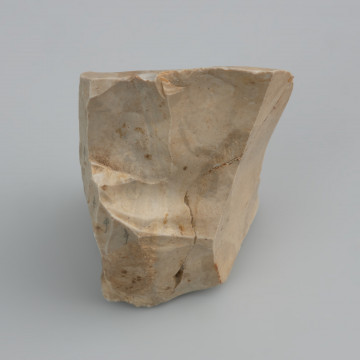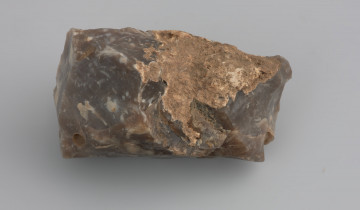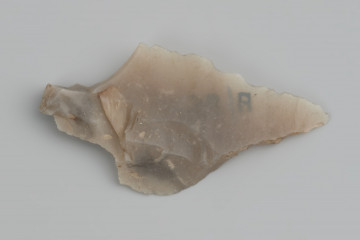
Single-stacked chipboard core
12700 p.n.e. — 11900 p.n.e.
National Museum in Szczecin
Part of the collection: Stone Age
The blade core of the Bromme culture was discovered in Lubieszewo, the Gryfice district. The site from which it came was known already in the interwar period. A cemetery and settlement from the Iron Age were discovered there, and in several cavities, traces of settlements from the Old and Middle Stone Age were found, including a small collection of flint products connected with the hunter-gatherer community of the late Palaeolithic Bromme culture. The core was made from a lump of local chalk flint of very high quality. It is the so-called double-heel specimen; it has two planes prepared to break off the half-product for tool making. The main heel was used to extract chips, while the second is the so-called auxiliary heel. The core from Lubieszewo was exploited using a soft pestle, probably from antlers. A characteristic feature of the flint manufacture of the people of the Bromme culture was to strike directly at the heel rather than at its edge, so the chips are relatively easy to distinguish from the half-product obtained by communities representing other archaeological cultures. These are elongated triangular-shaped chips, which are then made into leaf blades, javelin and arrowheads, sometimes also used as knives, as evidenced by the marks preserved on them. The Bromme culture is the oldest of the Palaeolithic cultures from the circle of the so-called cultures with tanged points. The people of that culture inhabited diverse ecological niches in the rare birch-pine forests, which covered the northern areas of Europe at the end of the last glaciation. The economy was based on non-specialised hunting and gathering.
Michał Adamczyk
Author / creator
Dimensions
cały obiekt: height: 10.4 cm, width: 3.8 cm
Object type
lithic core, production waste
Technique
carving, hard masher carving, soft masher carving
Material
flint, stone
Origin / acquisition method
field research
Creation time / dating
Creation / finding place
Owner
National Museum in Szczecin
Identification number
Location / status

12700 p.n.e. — 11900 p.n.e.
National Museum in Szczecin

9600 p.n.e. — 9000 p.n.e.
National Museum in Szczecin

10800 p.n.e. — 9000 p.n.e.
National Museum in Szczecin
DISCOVER this TOPIC
Castle Museum in Łańcut
DISCOVER this PATH
Educational path